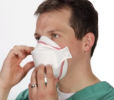The Case for Use of masks by Public in an Epidemic (Coronavirus) - Registered Nurse
 Here is the case for wearing masks whether you are infected or not. In my opinion, people should proceed as if they are infected and wear a mask in order to protect others in the community. Waiting until you are infected is like closing the stable door after the horse has bolted. None of us know when or if we are infected until/if symptoms arise and are tested. We could be infected without ever knowing. If we all wear masks (and gloves) in public we can substantially reduce infection risk. Official support for this would help us to overide embarassment or the stigma involved in initiating a new public behaviour. Shop owners and other businesses with a public interface can reassure the public by offering masks and gloves at the entrance, and keeping alcohol wipes close to cash registers and electronic keypads, and wiping them with every use or making sure that customers wipe them with every use (and wait 10 minutes between uses).
Here is the case for wearing masks whether you are infected or not. In my opinion, people should proceed as if they are infected and wear a mask in order to protect others in the community. Waiting until you are infected is like closing the stable door after the horse has bolted. None of us know when or if we are infected until/if symptoms arise and are tested. We could be infected without ever knowing. If we all wear masks (and gloves) in public we can substantially reduce infection risk. Official support for this would help us to overide embarassment or the stigma involved in initiating a new public behaviour. Shop owners and other businesses with a public interface can reassure the public by offering masks and gloves at the entrance, and keeping alcohol wipes close to cash registers and electronic keypads, and wiping them with every use or making sure that customers wipe them with every use (and wait 10 minutes between uses).
In Australia and in many western countries, the public have been advised that they should not wear a mask unless they are infected. The explanation is that a mask helps to prevent droplets escaping from an infected person, and that it will not protect an uninfected person from other unmasked peoples' droplets. The problem is that people cannot know whether we have been infected and will only find out if they become ill or are linked to a known infected person and thence formally diagnosed. So if we behave as if we are infected, and wear masks, we will be increasing public safety by reducing droplet transmission through use of the mask as a barrier. We need to be careful when we remove the mask; we should avoid touching the exterior and abrupt movements that might dislodge droplets from the outside. See third video at the end of this article.
Most of us realise there is a logical dissonance in the advice we are receiving about masks. Some of us think this is because of the shortage of masks. The government should be ensuring local manufacture and distribution of quality masks. Unfortunately it is unlikely that really effective masks will become available to the general public - due to problems of supply as much as policy.
In the meantime, it is possible to make relatively effective masks to prevent the spread of infection, as in the first video. These are basically absorbent barriers and last 2-4 hours. The second video evaluates different kinds of mask, notably the N95 mask (which excludes up to 95% of particles). The third video explains how to use and remove a commercially manufactured N95 mask.

Recent comments